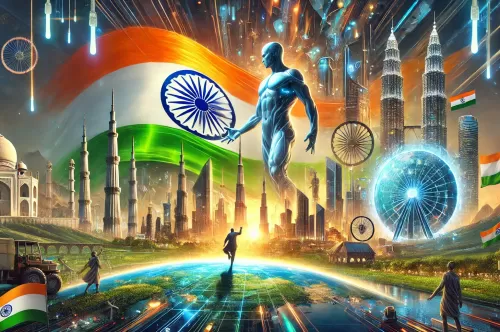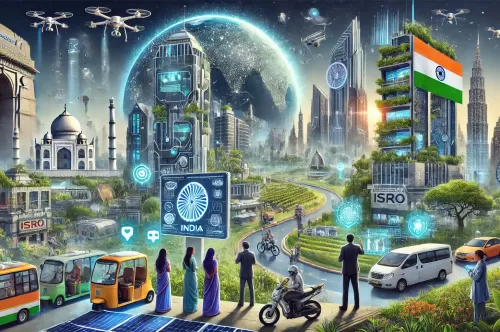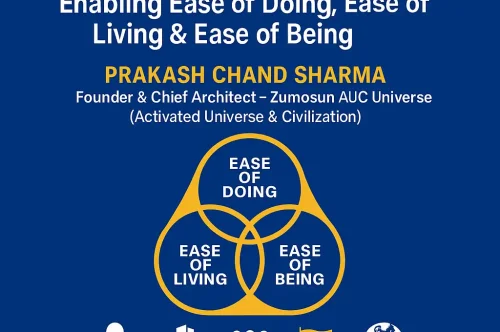India as a Global Superpower @ 2060: A $50 Trillion GDP Vision, Authored by Prakash Chand Sharma

ndia as a Global Superpower @ 2060: A $50 Trillion GDP Vision
Authored by: Eng. Adv. CA-D Prakash Chand Sharma
Founder, Zumosun Group
Abstract
By 2060, India stands poised to redefine global economics, governance, and innovation, emerging as a $50 trillion economy and an unparalleled global superpower. This white paper outlines a transformative roadmap focusing on multidimensional growth through technology, governance, education, and sustainability. It emphasizes the pivotal role of India’s demographic dividend, resource optimization, and innovative ecosystems to achieve this audacious vision.
1. Introduction: The Vision of India @ 2060
India’s rise as a global superpower by 2060 hinges on sustainable economic growth, socio-political stability, and technological leadership. Achieving a GDP of $50 trillion requires an annualized growth rate of approximately 8-9%, driven by:
- Strategic investments in key industries.
- Robust governance and policy frameworks.
- Global partnerships for trade and innovation.
This paper examines India’s opportunities, challenges, and actionable steps to transform the nation into a beacon of global prosperity.
2. Strategic Pillars for Transformation
2.1. Economic Transformation: Building a $50 Trillion Economy
-
Industrial Growth and Diversification
- Boosting sectors like advanced manufacturing, renewable energy, and AI-driven technologies.
- Encouraging small and medium enterprises (SMEs) as growth engines.
-
Global Trade Leadership
- Expanding India’s share in global exports from 3% to 15%.
- Focusing on high-value industries such as semiconductors, pharmaceuticals, and green technologies.
-
Infrastructure Development
- Investment of $5 trillion in smart cities, transportation, and digital infrastructure.
- Integration of rural and urban economies through advanced logistics.
2.2. Technological Dominance
-
Digital India 5.0
- Expanding AI, blockchain, and quantum computing industries.
- Establishing India as a global hub for cloud computing and cybersecurity solutions.
-
Space Exploration and Leadership
- Increasing ISRO’s role in global space missions.
- Monetizing space-based technologies for communication and resource mapping.
-
Indigenous Innovation
- Allocating 5% of GDP for R&D across science, medicine, and engineering.
- Fostering innovation hubs through academia-industry-government collaboration.
2.3. Governance and Policy Evolution
-
Transparent and Inclusive Governance
- Leveraging blockchain for governance to ensure accountability and efficiency.
- Streamlining tax policies and ease of doing business to attract global investments.
-
Geopolitical Leadership
- Strengthening India’s voice in international organizations like the UN, WTO, and IMF.
- Forming strategic alliances in Asia, Africa, and Latin America for mutual growth.
2.4. Education and Skill Development
-
Education 4.0
- Transitioning to an AI and automation-compatible education system.
- Prioritizing STEM education and entrepreneurial skill development.
-
Skill Development Mission
- Upskilling 1 billion individuals to meet global workforce demands.
- Integrating vocational training with formal education systems.
2.5. Sustainability and Climate Leadership
-
Net-Zero Economy
- Achieving carbon neutrality by 2050 through renewable energy investments.
- Expanding electric mobility and green building initiatives.
-
Global Green Partnerships
- Leading global collaborations for water conservation, afforestation, and clean technologies.
2.6. Social Inclusion and Equity
-
Eradicating Multidimensional Poverty
- Universal access to healthcare, education, and financial inclusion.
- Empowering marginalized communities through targeted welfare programs.
-
Gender Equality and Diversity
- Ensuring 50% female participation in the workforce.
- Promoting diversity across industries and governance structures.
3. India’s Competitive Advantages
-
Demographic Dividend
- By 2060, India’s working-age population will remain a key driver of global growth.
-
Geostrategic Positioning
- Leveraging its position between Europe, Asia, and Africa for trade dominance.
-
Cultural and Soft Power
- Expanding global influence through media, education, and tourism.
4. Challenges and Mitigation Strategies
4.1. Economic Inequality
- Strategies: Promoting equitable wealth distribution through progressive taxation and welfare schemes.
4.2. Political Instability
- Strategies: Strengthening democratic institutions and fostering policy continuity.
4.3. Climate Vulnerability
- Strategies: Investing in resilient infrastructure and disaster management systems.
4.4. Technological Disparities
- Strategies: Ensuring digital literacy and technology access for all.
5. Implementation Roadmap
5.1. Phase 1: 2024-2035 (Foundation)
- Focus: Infrastructure, policy reform, and basic digitization.
5.2. Phase 2: 2035-2045 (Growth)
- Focus: Advanced manufacturing, renewable energy, and global partnerships.
5.3. Phase 3: 2045-2060 (Global Leadership)
- Focus: Technological dominance, space exploration, and geopolitical influence.
6. Conclusion
India’s ascent to a $50 trillion GDP by 2060 is not merely a dream—it is a collective mission. Through strategic investments, inclusive governance, and technological prowess, India will redefine global paradigms of growth and equity.
This vision is not just for India but for a world that thrives on shared prosperity and innovation. Together, let us lead the global revolution.
Author's Note:
This white paper represents a call to action for policymakers, entrepreneurs, and citizens to unite under a shared vision of transforming India into a global superpower. It embodies the spirit of "Atmanirbhar Bharat" and reflects the immense potential of India’s people and institutions.
"Lead the Global Revolution."
About The Author:-
Prakash Chand Sharma, a multi-talented leader, defies labels. He's a pioneer of "The Doctorate of Growth & Success" and the Work Engine Network. Sharma seamlessly blends expertise in engineering, law, finance, and business.
His academic background (visiting professor) combined with engineering, legal practice, and tax consultancy experience showcases his intellectual depth. Over a decade of entrepreneurship across various sectors, coupled with leadership positions in multiple companies, has honed his strategic vision.
This unique blend positions Sharma as a transformative leader and a sought-after mentor. His visionary leadership has driven the success of the Zumosun Group, a diversified conglomerate. His dedication to growth extends beyond business with his innovative "The Do.GS" concept.
Follow On:-
1. https://www.linkedin.com/in/eng-adv-ca-m-prakash-chand-sharma-26586143/
2. https://www.facebook.com/er.adv.ca.prakash.chandsharma.35






